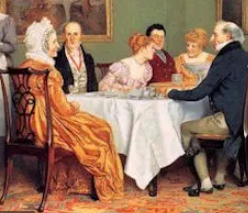Copyright (c) Jane Austen’s World. Post written by Tony Grant, London Calling.
In 1754 David Garrick became the lessee first and finally bought the house, which was to become his villa beside The Thames.
It became his country retreat and the place where he and his wife entertained friends. He began to alter the original building, which had parts that dated back to the middle ages, and employed his friend Robert Adam to redesign the façade in a classical style.Capability Brown advised on the layout of the gardens. The Kingston to Staines Road runs outside the front of the house today and it did also in the 18th century.
Garrick had a tunnel dug from the front of his villa under the road to his gardens beside The Thames which today is called, Garrick’s Lawn. On this lawn, beside The Thames, Garrick had a temple to Shakespeare built. Inside was placed a very fine statue of Shakespeare designed by Roubiliac, another friend. When Garrick died, his wife Eva, gave it to the British Museum. A copy of the statue now has been placed inside the temple.
Garrick added an orangery at the far end of the main garden which backs onto Bushy Park. Adam also designed the orangery in the main garden with a corinthian façade and classical entablature. Garrick owned much of the farmland, which is now Bushy Park. He also bought other houses in Hampton, including Orme House in Church Street, The Six Bells pub, later named The White Heart, Garrick’s Ait, the island opposite the temple and the villa and three other aits on The Thames. Just before his death, Garrick bought The Cedars, now called Garrick House, which you drive past on the Kingston Road.
In 2008 some work was being done on the villa when a fire broke out. The entire roof of the grade 1 listed building collapsed. The second floor also caught fire. It took ten fire engines to bring the blaze under control and save the shell of the house. It is now undergoing extensive rebuilding. The house is a symbol of the English Theatre and must not be lost to the nation and the world.
David Garrick came from humble origins in Leicestershire. His family were Huguenot immigrants who had to struggle and fight for their survival and success. Garrick continued this need for success. He had an incredible talent as writer, actor and innovator. His greatness can only be measured by his influence on theatre and acting today.
What is interesting is his need to acquire property and land, to have the best in architecture and to keep acquiring, throughout his life. Was this the sign of an inner drive to stay successful, to gain security, to not allow himself to revert to lowly circumstances? Was he a driven personality? This reminds me of another driven personality, Charles Dickens, who literally worked himself to death. He too saw property and one house in particular, as a sign to himself and others that he was at the top, that he had made it.
The house was Gads Hill in Kent just outside of Rochester and Chatham. After Dickens death, John Foster, a great publishing friend of Dickens wrote, “ upon first seeing it (Gads Hill) as he came from Chatham with his father and looking upon it with much admiration he had been promised that he might himself live in it or in some such house when he came to be a man, if he would only work hard enough.”
Of course Dickens did work. He probably had more need to stay at the top than even Garrick. His father was notorious for getting into debt and had ended up in debtors prison. Cahrles Dickens had had to work in a blacking factory in almost slave like conditions. This affected Dickens for the rest of his life.
Both Dickens and Garrick were influenced greatly by Shakespeare. Garrick as actor and theatre owner. Garrick’s greatest performance was playing Richard III. Dicken’s house at Gads Hill was the very spot, in Henry IV part I, where Prince Hal waylays and robs Falstaff as a prank or joke. Of course Dickens absolutely loved this connection. There is another rather obscure link with Garrick. David Garrick had a tunnel dug under the road in front of his villa to get to his garden beside The Thames. Dickens purchased the land on the opposite side of the road to his house at Gads Hill and had a tunnel dug in front of his house under the road to get to it.
Dickens had a small wooden Swiss Chalet built on the other side of the road where, towards the end of his life, he wrote. Passing through a tunnel to the beautiful scenery of The Thames or to a place to work could be read as having deep psychological meaning I am sure.
David Garrick’s villa can be seen as his badge of success. A symbol of all his striving and hard work.
Where do our middle class ambitions get us? Are we driven? Where have we come from and where do we want to go? Are we working like Garrick and Dickens to prove something? How desperate are we and are we happy with it? I wonder if Dickens was ever happy? Maybe in the heightened hyper reality that he achieved in his live readings, but that was fleeting. He was driven, so was Garrick and are we?
I know this an odd request on this site but you never know who might read this stuff. To any Hollywood Super Star out there. You owe everything, your whole profession, to David Garrick. If you have some spare cash, go on, pay for the refurbishment of Garrick’s Villa. It could be your real contribution to the world.
More on the topic:





















This is absolutely amazing. Just loved this article. Charles Dicken’s is one of my favorite authors, besides of course Jane Austen. Tony, is there a fund set up for the renewal work to be done on Garrick’s Villa? Thank you for this wonderful article.
Hi Harry. Thank you for your very kind and enthusiastic response to my article.
I have e-mailed The Garrick Club in London asking them if there is a fund people can contribute to for the restoration.
Thanks once again for your interest.
I will get back to you if I hear from them.
All the best,
Tony
Thank you Tony, and Vic, for a most interesting series. I knew of David Garrick, but my knowledge was miniscule; I feel like I’ve learned a lot and it is fascinating. And, of course, your images are lovely, as always, Tony. Thanks again,
Cathy Allen
Hi Tony
A really interesting article. I was drawn to it as here at Compton Verney, where I work, we have a mansion re-designed by Robert Adam with surrounding parkland landscaped by Capability Brown – I wasn’t aware that this formidable duo had worked on other projects together. Would love to show you around if you happen to be in Warwickshire.
You’ve also answered a long standing question about that curious Swiss Chalet I have so often passed.
Now about to delve into more articles in your blogroll.
Best wishes Sam
Hi Sam.
If I pass by your way I will most certainly come into Compton Verney and say hello. Thank you for your comment.
All the best,
Tony